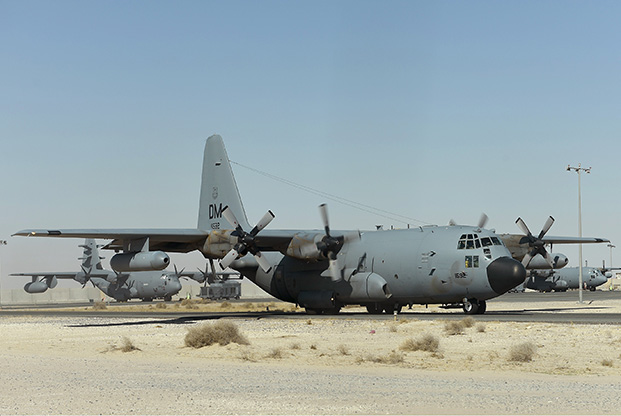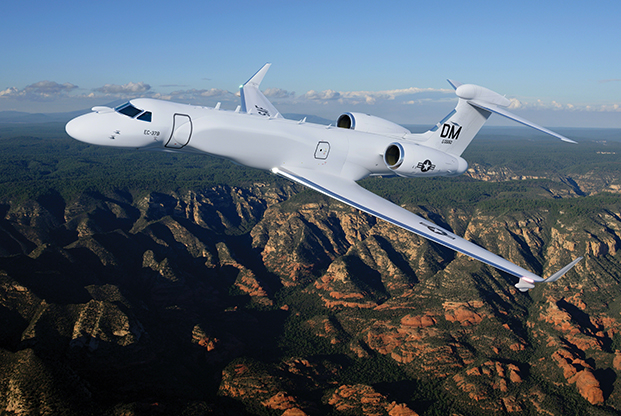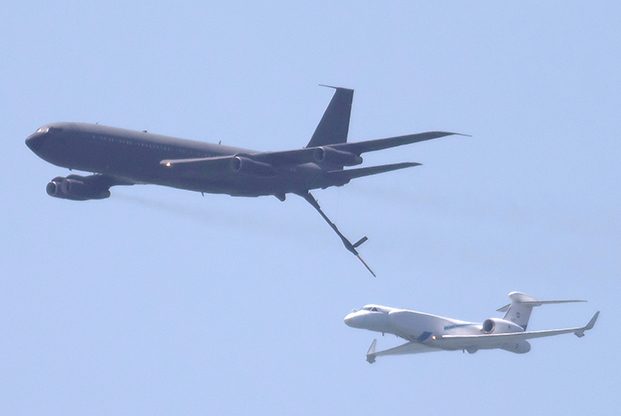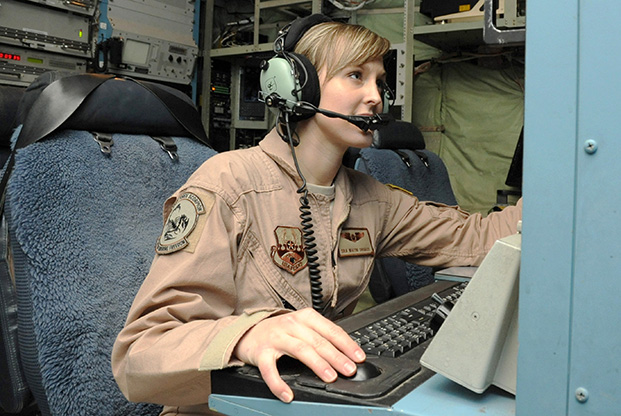
An EC-130H Compass Call taxis at an undisclosed location in Southwest Asia. The aircraft type has been flying nonstop in the region for more than 15 years. Photo: TSgt. Jonathan Hehnly
Transplanting the innards of the Air Force’s Compass Call electronic warfare aircraft to a new host platform is finally underway, after an exhausting prelude of protests, congressional interference, and public criticism of USAF’s acquisition strategy on the project.
On Sept. 7, 2017, USAF awarded the first contract action to L3 Technologies to begin removing critical equipment from the aged EC-130H fleet for installation on fresh Gulfstream G550 business jets. The small, 14-aircraft EC-130H fleet has been flying since 1981—and near-constantly in the Afghanistan, Iraq, and Syrian conflicts, because of the unique capability it offers in communications jamming and electronic attack. It has been a key element in the fight against ISIS, an adversary that has adapted high technology to its tactics and strategy.
While USAF has struggled to rehost the Compass Call mission, the EC-130Hs have soldiered on. They deny “time-critical” enemy coordination in ongoing combat, according to Air Forces Central Command.
The EC-130Hs deployed for Operation Inherent Resolve have an autonomous electronic attack capability that can’t be matched by any other aircraft. The airplane carries a team of linguists who monitor ISIS communications, while electronic warfare officers use the aircraft’s electronic attack weapons system to target and block communications when needed.
The aircraft help prevent “the information from getting to the boss” and “prevents the boss from ever being able to direct his forces,” Capt. Tim West, director of operations for the 43rd Expeditionary Electronic Combat Squadron, recently told Air Force Magazine.
“We are inducing massive confusion and friction into their operations that make them ineffective as a fighting force,” Lt. Col. Josh Koslov, 43rd Expeditionary Attack Squadron commander, said in an Air Force news release.
Because the mission has been both crucial and ever-changing, the electronic gear on the Compass Call has been constantly refreshed in recent years. So while the EC-130Hs are largely worn out, their equipment does not need to be replaced. That’s why the Air Force came up with the idea of “cross-decking;” taking the equipment from the old airplane and putting it on a new one. The final decision to cross-deck equipment from the EC-130Hs to the new bizjets was made because it could be done “quicker than we could any other way, getting a critical need to address something out in the future—a threat that is evolving,” said Lt. Gen. Arnold W. Bunch Jr., USAF’s top uniformed acquisition official, speaking with lawmakers last May.
In awarding the project to L3, the Air Force let the company pick the aircraft it deemed best-suited to carry the electronic warfare gear.
USAF’s acquisition strategy ignited multiple protests, spurring a Government Accountability Office review that dragged throughout 2017.

An artist’s concept of a Gulfstream G550 in Compass Call configuration. Critical equipment from the aging EC-130H fleet will be installed on the business jets. Photo: Gulfstream illustration
PREMATURE RETIREMENT
The Air Force took its first major step to shed the old EC-130H airframes in 2014. It was then that the service proposed a plan to Congress to retire the existing Compass Call fleet outright. This was in response to what USAF described as budget constraints and evolving worldwide threats that would reduce future effectiveness of the fleet.
This step faced immediate and strident congressional opposition, especially from Arizona lawmakers with constituencies near Davis-Monthan AFB, Ariz., where the Compass Call fleet is based. The move was stymied.
In the Fiscal 2016 National Defense Authorization Act, lawmakers called on the Air Force to submit an explanation for retiring the Compass Call, specifically calling on the service to outline how it might transfer the perfectly good mission equipment to another platform.
While it pondered this direction from Capitol Hill, USAF took a formal step in October 2015, releasing a request for information to industry. It wanted to know if aircraft manufacturers could provide a commercial derivative aircraft that could carry the the Compass Call system and meet all mission requirements.
Industrial competitors replied that the switchover could be done. The responders included Boeing, offering its 737 aircraft, Bombardier pitched its Global 6000, and Gulfstream proposed its G550 jet.
These aircraft became the candidates for cross-decking, which involves removing the antenna array components from the prop-driven EC-130Hs and installing them on each side of a new jet in “cheek” blisters. The Compass Call avionics, wiring, operator consoles, power supplies, and other equipment would then be removed from the EC-130H, installed on the new platform, and flight tested.
_You can read this story in our print issue:
The Air Force notified Congress in April 2016 that Gulfstream’s offering was “the only one on the market that meets size, weight, power, cooling, aperture, and performance requirements and does not require development and/or certification work that would prevent meeting schedule needs.” About four months later, USAF issued a classified “justification and approval” authorizing a sole-source award to L3 Communications for the cross-deck process.
L3 has been the sole company providing maintenance and integration on the current EC-130 fleet for the past 15 years, and the Air Force claimed because of national security interests and the classification of the equipment, L3 needed to be the company doing the work.
“L3 has played the role of systems integrator as we’ve modernized these aircraft over the last 15 years,” Bunch said. “They are the ones that are very familiar with the mission equipment that’s on there. That mission equipment is highly classified to be able to execute the electronic warfare mission we ask that platform to do. They have all the tooling, they have all the existing knowledge, and they have all the modeling and all the information they need to do that work.”
L3 was the only company capable of performing the “critical function” of selecting, “based on market research, the aircraft subsystem and perform the mission equipment integration effort,” an Air Force spokeswoman told Air Force Magazine.
Congress blessed the program in the Fiscal 2017 National Defense Authorization Act, giving the Air Force permission to “carry out a program” transferring primary mission equipment from an EC-130 to an “aircraft platform” that the service deemed “more operationally effective and survivable” than the current C-130 platform.
The Air Force had already told Congress that the G550 was the only airplane meeting its requirements, even before a contract was awarded.
After Congress green-lighted the plan for Fiscal 2017, Bombardier filed a protest with the Government Accountability Office last February, claiming the sole-source award, the classified justification, and the approval process were improper and claimed L3’s choice of the Gulfstream jet at USAF’s urging was inappropriate. The Bombardier protest was dismissed as premature by the GAO because there hadn’t been a formal solicitation.

An Israeli Air Force tanker refuels a G550 airborne early warning aircraft during an Independence Day flight over Israel. Photo: Zigi
MOUNTING PROTESTS
The formal solicitation came in May, as the Air Force called on L3 for a proposal backing the definitization of a sole-source contract. The statement of work for the contract called on L3 to deliver one rehosted aircraft and provide a “comprehensive analysis” supporting its choice of aircraft and subcontractor.
Eleven days later, Boeing filed its own protest with the GAO, claiming it could both do the cross-decking work and provide a 737 to meet the requirements.“We believe that the US Air Force and taxpayer would be best served by a fair and open competition, and that the Air Force can still meet its stated time line of replacing the aging fleet of EC-130Hs within 10 years,” Boeing spokeswoman Caroline Hucheson said at the time.
Bombardier filed a protest too, on May 26, claiming its Global 6000 could meet the requirements, but it did not claim it could do the integration work. The main claim in the protests was that the Air Force was telling L3 to pick Gulfstream for the subcontract award without a valid basis. The companies also claimed that the award violated the law, violated a prohibition on the award of contracts for governmental functions, and that the proposed award was a prohibited lead systems integrator contract.
Lastly, Boeing, in its protest, also claimed it could perform the rehost work and that a sole-source award is improper because of an unmitigable conflict of interest arising from the relationship between L3 and Gulfstream. The two companies are already working together, along with Northrop Grumman, on the Air Force’s Joint Surveillance Target Attack Radar System (JSTARS) recapitalization, and the two companies work together on G550-based systems for foreign militaries.
In April, L3 CEO Michael Strianese shrugged off Boeing’s claim. In a first quarter conference call with investors, he said no decision had been made on the aircraft saying, “it could be a 737. It could be one of multiple business jets.”
After three months, the GAO made its decision—rendered secretly at first. In a 22-page justification, the agency rejected all the claims from both Boeing and Bombardier.
The claim that the Air Force directed L3 to choose Gulfstream was rejected because, although the service said the G550 was the only aircraft that could meet its requirements, the GAO stated that the award didn’t specify any specific aircraft for the award. The sole-source award didn’t violate the 2017 authorization act because the law didn’t require USAF to conduct its procurement in the way alleged by the companies.
The GAO stated the sole-source award didn’t meet the definition of a prohibited contract for services or the definition of a prohibited contract for lead systems integration. The GAO also denied Boeing’s claims because the company didn’t demonstrate that the justification and approval was unreasonable, and the company failed to demonstrate a conflict of interest regarding L3 and Gulfstream.

SrA. Whitni Orgass, a cryptological language analyst, works aboard a Compass Call out of Bagram Airfield, Afghanistan. Photo: SSgt. Davud Dobrydney
STEP ON IT
The Air Force moved quickly after the GAO auditors rendered their findings, awarding on Sept. 7, 2017, the undefinitized contract action to L3 to move equipment from the EC-130H Compass Call. The program also got a name: EC-X.
Then, in a long-expected move, L3 decided on the Gulfstream platform.“After their analysis and sharing that with the program office, L3 has decided to use the Gulfstream G550 Airborne Early Warning aircraft as the new platform,” the Air Force said in a statement announcing the contract. Things moved rapidly after that. A preliminary design review was completed in late September, only a few weeks after the GAO decision.
The EC-X is not the first use of the Gulfstream G550 by the Air Force. The type is currently flown by USAF as the basis of the C-37B used for VIP transport.
Northrop Grumman also chose the G550 as the mount for its version of the proposed JSTARS recap, which would adapt the jet to provide ground moving target indication. While a speedy replacement of the existing E-8C JSTARS fleet is USAF’s preferred outcome, the service does not plan to simply cross-deck equipment from those aircraft to whatever airplane is chosen for the new JSTARS. In that contest, Boeing is also offering an adaptation of its 737, and Lockheed Martin’s version would ride on the Global Express business jet.While the Compass Call replacement acquisition program moves forward, the Air Force is pressing to keep its current fleet modern and capable. In 2016, the service kicked off a $45 million upgrade called the “avionic viability program” that keeps the fleet in line with Federal Aviation Administration and international regulations on flight information and provides a “glass” liquid crystal display information suite in the cockpit.
The upgrade, which is ongoing, helps “increases the pilot’s situational awareness tenfold,” said Maj. Gerardo Sanchez, the assistant director of operations for the 42nd Electronic Combat Squadron, when the program began installation in August 2016.
The fleet is still showing its age, which is reflected in its availability. In 2015, as Operation Inherent Resolve hit a high operations tempo, the EC-130H fleet had just a 72 percent mission capable rate—more than a quarter of the aircraft were not available for operations. The fleet requires “unique and specialized” maintenance support downrange, with specialized maintainers from Davis-Monthan deploying alongside the aircrews to try to keep the aircraft flying.“We do not fly our mission without our maintainers dedication and effort,” said Lt. Col. Matthew Cunningham, an EC-130 aircraft commander, in an August 2017 release about the Compass Call’s current operations.In Afghanistan, the deployed EC-130 crews hit a 27-month record high for mission capability of 96.5 percent in November 2016. That crew, from the 455th Expeditionary Aircraft Maintenance Squadron, had 146 deployments among them. EC-130Hs there have been deployed nonstop since 2002, the longest continuously deployed Air Force unit in the Afghanistan war.